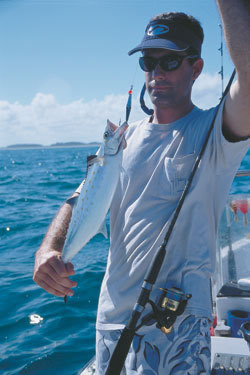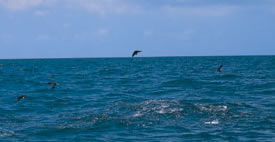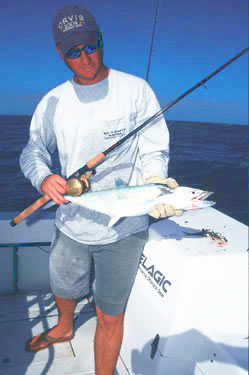May 16, 2011
By David Conway
Light-tackle fun in the lower Keys.

A great way to hook Spanish mackerel is to cast a silver spoon into feeding schools.
|
Cero and Spanish mackerel are the unsung heroes of Key West's nearshore waters. The schools, often mixed together, blast baits with abandon as they swarm the wrecks, reef and patch reefs around the island. The only mystery about these fish is why anglers pay them so little attention. Target the smaller macks on light tackle and you'll quickly see they are as capable of stunning runs and heart-stopping head shakes as their bigger cousins, the kings.
Maybe it's because they're so abundant that they're taken for granted. Ceros are year-round residents of the Lower Keys, and in the cooler months, Spanish migrate from the north to join them. You'll see their fast-moving schools in 20 to 60 feet between the islands and the reef, slashing the surface after baits, often as you motor past them on your way out for sails, tuna or grouper. Or maybe their reputation comes from their admittedly annoying knack for severing lines with their laser-like eyes and razor teeth.
Whatever the reasons for their rap, Capt. Steve Hassell and I quickly learned to appreciate these underrated fish on a day when we were penned in by high winds and had to stay close to shore. I wound up rediscovering Key West's nearshore, mixed-bag fishery, and I'd put Spanish and ceros at the top of that class.
In fact, accessibility is the first virtue of going after the smaller mackerel. Depending on the wind direction, plenty of spots at all compass points—in the Gulf, in the Northwest Channel, and along Hawk's Channel on the Atlantic side, many of them marked on Florida Sportsman Chart #11, offer excellent mixed-bag fishing featuring mackerel, Spanish especially. The ceros show inshore also, but the big ones, world records, are better known for schooling at the reef.
Ceros and Spanish can be caught by the same methods, in the same places, and at the height of their run near Key West in January through March, both ceros and Spanish average about four pounds. So it's understandable that anglers sometimes mistake one species for the other. The simplest identifier is the subtle coloration difference. Ceros have a distinct yellow lateral line, and are seldom found in Florida above the Keys. Spanish have only bright yellow dots on their silvery skin.
It's also noteworthy that ceros exist only in the warm Caribbean and some southerly Gulf waters by Texas, and nowhere else in the world. To make matters more interesting, scientists believe that there are two stocks of Spanish mackerel, one in the Gulf and one in the Atlantic. Both species spawn offshore starting in April. By then, the Spanish have started their northern migration, staying in waters above 68 degrees, and following the warming trend north. Their stocks move way up the eastern seaboard. Anglers in the Keys have a shot at either species year-round, but winter is the best season.
Captain Hassell and I started our day by netting pilchards and anchoring at the markers right in front of Key West, the most popular places to pick up blue runners and ballyhoo. East winds raged behind us, and while we collected a few blue runners on sabikis for the livewell, we listened to reports of rough seas and scuttled our plans to go offshore. Instead, we'd check the patch reefs along the shoreline, where Spanish congregate, before we turned north into the Gulf at Boca Grand and headed to the Grouper Bar.

Freewheeling birds lead to feeding mackerel.
|
We anchored over one of Hassell's favorite patch reefs in Hawk Channel and set out the chum bags, hoping to attract a passing cobia or a few good snappers. First to arrive in our chumline behind our stern was a school of ballyhoo. A mack flashed through and scattered the ballyhoo on the surface, and then another cut the water like a knife. When the ballyhoo reschooled after a few minutes, Hassell had his cast net in hand.
“You can only take one throw at ballyhoo before they'll scare off for awhile,” he said, “and you should take it soon after they show up, because they tend to drift away and disappear. You've also got to time that throw right, because they spook so easy. If they stay deep, you can put a few drops of menhaden oil into the water and that will bring them right to the surface where the net gets them.”

Frozen block chum carried by the currents attracts both bait and predatory mackerel.
|
He flung the net and caught ten ballyhoo. He hooked one in its lower jaw and wrapped its bill with wire. We tossed that bait back 30 feet and let it rest a minute. Only when we twitched it did we get the take and the blazing run of the cero mackerel.
Almost immediately, we took another bright cero on a live ballyhoo. We might have stayed there all day and had a good time, but we wanted to try to make it to the Gulf.
“Back in the Gulf, I'll put a live blue runner on a kite for kings and drift smaller live baits like ballyhoo or pilchards back for ceros and Spanish,” Hassell said. “You'll find schools of Spanish back there, and sometimes they run with bonitos, which are tougher to track. Out here on the Atlantic side, schools of Spanish are always working near the Northwest and Southwest channels this time of year. Watch for feeding birds, and troll or cast a silver spoon to them.”
That silver casting spoon on a light wire leader gives you enough range to reach those schools and a sure-fire offering to match what they're after. Targeting them beneath birds is probably the most popular method for catching ceros and Spanish near Key West, but it wasn't going to be ours that day, because by the time we reached the mouth of Key West Harbor, winds had picked up even higher. We didn't want to punish ourselves with a rough ride, so we scuttled plans for the Gulf.
Yet we didn't want to call it a day either, so we ducked into the harbor and headed up the Northwest Channel, which runs like a piscatorial superhighway between the Atlantic and the Gulf. In winter, permit, cobia, kings, muttons, jacks, snapper and resident and seasonal tarpon use the channel to get around, and Key West Harbor is a rest stop along their way. So both the harbor and the Northwest Channel are good places totake cover and save a day of fishing during rough weather.
We went to the east, anchored at a spot along nearby Calda Channel, little more than a baitcaster's throw from the island itself, and set up shop. All that marked on the depthfinder was a slight depression of a few feet, and what looked like a school of baitfish—good enough to attract mackerel.
Scale your tackle to the test to have the most fun with the inshore game. We had trout rods, 8-pound monofilament with a Bimini twist attached to a 25-pound leader with a blood knot, and an improved clinch knot to the terminal tackle—jig, lure or bait hook. No matter the terminal tackle, knots are preferred to swivels for their cleaner presentation to the fish, and because in schools, mackerel will hit that swivel in a flash and cut you off empty-handed, with spiteful frequency. Their excellent eyesight and voracious nature makes them slash at everything in hopes of finding a meal.

Frozen block chum.
|
The mackerel drill is similar to snappering—anchor, chum and wait till the scent gets out. You'll get connected in a matter of minutes, but to what might depend on the tide. Spanish bite on any moving tide, but they might take a half an hour or so to show up. They probably bite better in slightly cloudy water, which we had. Very dirty water makes them wary of other predators. Use an oily chum like menhaden, and figure on going through a block every hour. At the same time, start tossing out chunks of cutbait, a few at a time. Fresh is better, of course, but frozen threadfins, ballyhoo or mullet work, too.
“Sometimes when you burn through that chum, after a while, you can see the Spanish cutting across the surface, and that's when I like to go for them on fly,” Hassell said.
Flies, spoons, live shrimp and pilchards and ballyhoo, cutbait—Spanish and ceros take them all. A lot of people don't, however, jig for Spanish on the bottom. But like their counterparts offshore, the kings, Spanish and ceros feed on the bottom as well, and that's often where you'll find them first.

Cero mackerel have a distinct gold lateral stripe and dashes.
|
Tip your chartreuse or white 1/4- or 3/8-ounce pompano jig with that cutbait or a few frozen mojarra that you're tossing into the chumline. Cast upcurrent about 20 feet to give the jig better placement on the bottom before the current picks it up again. Once it's down, twitch it to simulate the movements of a shrimp or pinfish that the mackerel usually hunt along the bottom, and jig it even more if you're using a bare jig. Let it drift down current and jig it gently on the bottom. One local captain calls it “bipping it,” the way you do for pompano, to make it look like a shrimp hiding on the bottom. Often, they'll hit on the retrieve in the middle of the water column.
If you're in a big school, you might use a light wire, No. 3, attached to the leader by an Albright knot, to protect against their slashing teeth. Captain Hassell uses a haywire twist on the wire to the jig “to give the lure a little movement.”
It took me a minute to get a feel for the bottom bumping technique. I had to find the right compromise between the weight of the current pulling and the weight of the rig resisting that pull, but when I did, I knew it by the strike.
Our inshore parade of species started with lane snappers. Then acrobatic ladyfish. We took a couple of mangroves, and then blue runners, and a few yellowtail, and though macks hadn't shown yet, no one was complaining. It took a few minutes for the scent to get to the far-ranging Spanish mackerel, but a sudden singing drag, the strong run and quick rise to the surface indicated the Spanish blitz had begun. The fish's telltale turn to the boat, like their cousin the kings, confirmed it.
Spanish and cero mackerels can't resist live pilchards hooked through the nose and freelined to them. While pilchards are available for cast netting most mornings this time of year in the shallows on Key West's south side and on the south side of Boca Grande, it's not necessary to have them. Instead you can use cutbait, or live shrimp weighted with a slip-sinker if the current runs strong. It's a good trick when using a slip-sinker to put it on the double line before you tie on your leader with an Albright. If you leave a tag from your heavy leader at the Albright, the slip-sinker won't get past it and foul up with the hook. Your bait will also float nicely just above the bottom, and the fish won't feel the weight as the line runs freely through the sinker. Otherwise, double wrap the line through the sinker to hold it steady a couple feet above the hook. Since some anglers say that a wire leader puts the sharp-eyed mackerel off, if you're staying with monofilament and using bait, you can also use a long-shanked bait hook to put some distance between your line and the mackerel's teeth.
Nothing's guaranteed, but going after Spanish and ceros near shore around Key West will get you into fish. It's a mixed-bag game, filled with plenty of surprises and a lot of humble virtues. You can reach their haunts quickly, at any compass point, usually in a 20-minute ride from local marinas. As they did for us that day, mackerel can save a trip when the weather's too rough to go offshore, or when nothing much turns up out there. Also, jigging for them works and guarantees action for younger, impatient anglers, and those kids can usually handle the mackerel while building their angling skills on a strong-fighting fish. And for those who still aren't convinced by their sport potential or their taste on the plate, and who must have bigger game, remember that Spanish mackerel make great frozen trolling baits for bigger game offshore.
FS
